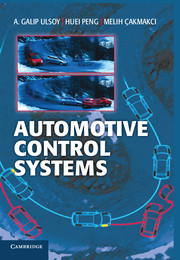Book contents
- Frontmatter
- Contents
- Preface
- Part I Introduction and Background
- Part II Powertrain Control Systems
- Part III Vehicle Control Systems
- Part IV Intelligent Transportation Systems
- 17 Overview of Intelligent Transportation Systems
- 18 Preventing Collisions
- 19 Longitudinal Motion Control and Platoons
- 20 Automated Steering and Lateral Control
- Appendices
- Index
- References
18 - Preventing Collisions
Published online by Cambridge University Press: 05 June 2012
- Frontmatter
- Contents
- Preface
- Part I Introduction and Background
- Part II Powertrain Control Systems
- Part III Vehicle Control Systems
- Part IV Intelligent Transportation Systems
- 17 Overview of Intelligent Transportation Systems
- 18 Preventing Collisions
- 19 Longitudinal Motion Control and Platoons
- 20 Automated Steering and Lateral Control
- Appendices
- Index
- References
Summary
Active Safety Technologies
An important motivation for AVCS technologies is safety, and a key safety technology is collision detection and avoidance systems. This type of safety enhancement is termed “active safety,” which is different from the traditional passive-safety concept (i.e., crashworthiness) (Sun and Chen 2010). The goal is to prevent collisions, not simply mitigate their effects. There are two major driving forces behind recent progress in the active-safety area, as follows:
The continuous progress in passive-safety systems has pushed the technology into a return/cost plateau. For example, a recent study shows that 42 percent of fatal-crash occupants can be saved by safety belts, and 47 percent can be saved with safety belts plus an air bag (Figure 18.1). For the remainder of accidents, the impact energy level is simply too high to be managed by reasonable engineering means using current technology. Most of these high-impact energy impacts, however, can be avoided altogether by active safety technologies (ASTs).
Recent changes in the standards for Corporate Average Fuel Economy (CAFE) continue to move toward reduced petroleum consumption in the United States. An important engineering approach for higher fuel efficiency is to lower vehicle weight; however, this solution is likely to raise safety concerns. It has been verified consistently that vehicle weight is the third-most important safety attribute for automobiles (i.e., after safety belts and air bags). Again, a possible solution to this safety concern is to apply ASTs.
Many enabling technologies and subsystems, which are useful for AST, have been widely available on passenger vehicles since 2005 (Table 18.1). Therefore, the add-on complexity and cost of introducing AST are greatly reduced. This fact, together with the obvious diminishing returns from passive-safety devices, has made active-safety systems increasingly attractive.
- Type
- Chapter
- Information
- Automotive Control Systems , pp. 322 - 331Publisher: Cambridge University PressPrint publication year: 2012

